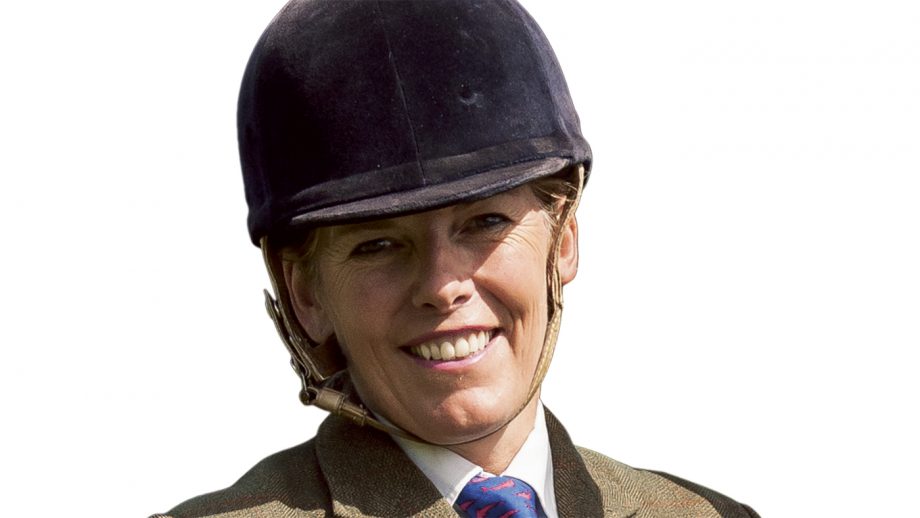It’s heartening to see the ways in which horse owners cope in these strange times. I’m so sorry for those unable to see their horses, but the overwhelming feeling is that we must plan, be positive and encourage each other as much as possible.
Riding schools and livery yards face enormous challenges, and the determination and initiative some businesses show is inspiring. I’m determined to stay positive, not least for the sake of the staff with us in self-isolation and for the clients trusting me to look after their horses.
{"content":"PHA+V2XigJlyZSB0YWtpbmcgdGhlIGNoYW5jZSB0byBzdGFuZCBiYWNrLCBzZWUgaG93IHJpZGVycyBhbmQgaG9yc2VzIGFyZSBwcm9ncmVzc2luZyBhbmQgd29yayBvbiBpbXByb3ZlbWVudHMuIFdl4oCZcmUgc3RpbGwgcmlkaW5nIGJlY2F1c2UgcmlkaW5nIOKAkyBhbGJlaXQgd2l0aCByZXN0cmljdGlvbnMsIHN1Y2ggYXMgbm90IGJhY2tpbmcgeW91bmdzdGVycyDigJMgc2VlbWVkIHRoZSBiZXN0IHdheSB0byBtYWludGFpbiBtb3JhbGUuPC9wPgo8cD5TbyBldmVyeW9uZSBoYXMgbW9yZSBsZXNzb25zIGFuZCBpcyBsZWFybmluZyBtb3JlIHRyYWluaW5nIHRlY2huaXF1ZXMuIE15IGhlYWQgZ2lybCBoYXMgbGVhcm50IHRvIHJpZGUgc2lkZS1zYWRkbGUgYW5kLCB0aGFua3MgdG8gbXkgZGF1Z2h0ZXItaW4tbGF3LCB3ZSBoYXZlIGEgeWFyZCBXaGF0c0FwcCBncm91cCBzbyBvd25lcnMgY2FuIGtlZXAgaW4gdG91Y2ggd2l0aCB1cyBhbmQga2VlcCB0cmFjayBvZiBob3cgdGhlaXIgaG9yc2VzIGFyZSBnZXR0aW5nIG9uLiBUcnlpbmcgdG8ga2VlcCBldmVyeW9uZSBwb3NpdGl2ZSBoZWxwcyBtZSBkbyBqdXN0IHRoYXQhPC9wPgo8aDM+TG9va2luZyBhaGVhZDwvaDM+CjxwPldl4oCZcmUgdGhpbmtpbmcgbm90IG9mIHRoZSBzaG93IHNlYXNvbiB3ZeKAmXZlIGxvc3QsIGJ1dCBvZiB0aGUgb25lIHdl4oCZcmUgcHJlcGFyaW5nIGZvci4gSWYgeW91IGNhbiByaWRlIOKAkyB3aXRoIGR1ZSByZXNwZWN0IHRvIHRob3NlIHdobyBjaG9vc2Ugbm90IHRvIG9yIGNhbuKAmXQsIGJlY2F1c2Ugd2UgYWxsIGhhdmUgaW5kaXZpZHVhbCBjaXJjdW1zdGFuY2VzIGFzIHdlbGwgYXMgd29yayBhbmQgZmFtaWx5IHNpdHVhdGlvbnMg4oCTIHlvdSBoYXZlIHNldmVuIGRheXMgYSB3ZWVrIHRvIHRyYWluIHlvdXIgaG9yc2VzLCBtb3N0bHkgaW4gbG92ZWx5IHdlYXRoZXIuPC9wPgo8cD48ZGl2IGNsYXNzPSJhZC1jb250YWluZXIgYWQtY29udGFpbmVyLS1tb2JpbGUiPjxkaXYgaWQ9InBvc3QtaW5saW5lLTIiIGNsYXNzPSJpcGMtYWR2ZXJ0Ij48L2Rpdj48L2Rpdj48c2VjdGlvbiBpZD0iZW1iZWRfY29kZS0zMSIgY2xhc3M9ImhpZGRlbi1tZCBoaWRkZW4tbGcgcy1jb250YWluZXIgc3RpY2t5LWFuY2hvciBoaWRlLXdpZGdldC10aXRsZSB3aWRnZXRfZW1iZWRfY29kZSBwcmVtaXVtX2lubGluZV8yIj48c2VjdGlvbiBjbGFzcz0icy1jb250YWluZXIgbGlzdGluZy0tc2luZ2xlIGxpc3RpbmctLXNpbmdsZS1zaGFyZXRocm91Z2ggaW1hZ2UtYXNwZWN0LWxhbmRzY2FwZSBkZWZhdWx0IHNoYXJldGhyb3VnaC1hZCBzaGFyZXRocm91Z2gtYWQtaGlkZGVuIj4NCiAgPGRpdiBjbGFzcz0icy1jb250YWluZXJfX2lubmVyIj4NCiAgICA8dWw+DQogICAgICA8bGkgaWQ9Im5hdGl2ZS1jb250ZW50LW1vYmlsZSIgY2xhc3M9Imxpc3RpbmctaXRlbSI+DQogICAgICA8L2xpPg0KICAgIDwvdWw+DQogIDwvZGl2Pg0KPC9zZWN0aW9uPjwvc2VjdGlvbj48L3A+CjxwPkhvcnNlcyBhcmUgbW9yZSByZWxheGVkIHRoYW4gaW4gdGhvc2UgY29sZCBwcmUtc2Vhc29uIGRheXMsIGFuZCBtaXhpbmcgdXAgdGhlaXIgd29yayBrZWVwcyB0aGVtIGhhcHB5LjwvcD4KPHA+SeKAmW0gZG9pbmcgcG9sZSB3b3JrIHdpdGggYWxsIG15IGhvcnNlcyBhbmQgZW5qb3kgdGhpbmtpbmcgdXAgZGlmZmVyZW50IGV4ZXJjaXNlcywgc29tZSBvZiB3aGljaCBJ4oCZdmUgc2hhcmVkIG9uIG15IEZhY2Vib29rIHBhZ2UuIFRoZXkgZG9u4oCZdCBoYXZlIHRvIGJlIGNvbXBsaWNhdGVkIGFuZCBoZWxwIGtlZXAgeW91IGFuZCB5b3VyIGhvcnNlIGZvY3VzZWQuPC9wPgo8cD5BIHNpbXBsZSBndWlkZSBwb2xlIGNhbiBoZWxwIHlvdSByaWRlIGRlZXBlciBpbnRvIGEgY29ybmVyIGFuZCBkaWZmZXJlbnRpYXRlIGEgY29ybmVyIGZyb20gYSBjaXJjbGUuIEFub3RoZXIgZmF2b3VyaXRlIGlzIHVzaW5nIHBvbGVzIGFzIGd1aWRlbGluZXMgZm9yIGEgc2hhbGxvdyBsb29wLCBhY3RpdmF0aW5nIHRoZSBob3JzZeKAmXMgaGluZGxlZyBhbmQgZW5jb3VyYWdpbmcgaGltIHRvIGJlbmQgY29ycmVjdGx5LiBQb2xlcyBjYW4gYmUgdXNlZCB0byBpbXByb3ZlIHJoeXRobSBhbmQgc3RyaWRlIGxlbmd0aCwgaW1wcm92ZSB0cmFuc2l0aW9ucyDigJMgaW4gZmFjdCwgaW1wcm92ZSBldmVyeXRoaW5nLjwvcD4KPGRpdiBjbGFzcz0iYWQtY29udGFpbmVyIGFkLWNvbnRhaW5lci0tbW9iaWxlIj48ZGl2IGlkPSJwb3N0LWlubGluZS0zIiBjbGFzcz0iaXBjLWFkdmVydCI+PC9kaXY+PC9kaXY+CjxoMz5JbmRpdmlkdWFsIHByZWZlcmVuY2VzPC9oMz4KPHA+TW9yZSB0aW1lIGFuZCBsZXNzIHByZXNzdXJlIHRvIGJlIGNvbXBldGl0aW9uLXJlYWR5IGNhbiBiZSBhIGJvbnVzLiBXaGVuIEkgd2FzIDE3IGFuZCB0cmFpbmluZyB3aXRoIFJ1dGggTWNNdWxsZW4sIEkgd2FudGVkIHRvIHJ1biBiZWZvcmUgSSBjb3VsZCB3YWxrLiBSdXRoLCB3aG8gdHJhaW5lZCBtYW55IHJpZGVycyB0byByZWFjaCB0b3AgbGV2ZWwgZXZlbnRpbmcgYW5kIHNob3dpbmcsIHRvbGQgbWUgSSB0cmllZCB0b28gaGFyZCBhbmQsIGV2ZW50dWFsbHksIEkgdW5kZXJzdG9vZC48L3A+CjxwPlByb2dyZXNzIGFuZCBpbXByb3ZlbWVudCBkb27igJl0IGdvIGF0IGEgc2V0IHBhY2UsIHNvIHRha2UgdGhlIHRpbWUgeW91IG5lZWQgcmF0aGVyIHRoYW4gdGhlIHRpbWUgeW91IHRoaW5rIHlvdSBzaG91bGQgbmVlZC4gU2ltaWxhcmx5LCBvbmUgb2YgdGhlIGZhc2NpbmF0aW9ucyBvZiB0cmFpbmluZyBob3JzZXMgaXMgZmluZGluZyBvdXQgdGhlaXIgaW5kaXZpZHVhbCBwcmVmZXJlbmNlcy48L3A+CjxkaXYgY2xhc3M9ImFkLWNvbnRhaW5lciBhZC1jb250YWluZXItLW1vYmlsZSI+PGRpdiBpZD0icG9zdC1pbmxpbmUtNCIgY2xhc3M9ImlwYy1hZHZlcnQiPjwvZGl2PjwvZGl2Pgo8cD5JdOKAmXMgaW1wb3J0YW50IHRvIGhhdmUgdHJhaW5pbmcgcHJpbmNpcGxlcywgYnV0IGNvbWJpbmluZyB0aG9zZSB3aXRoIHRoZSB3YXkgYSBob3JzZSByZWFjdHMgdG8geW91IHdvcmtzIGJlc3QgZm9yIG1lLjwvcD4KPHA+Rm9yIGV4YW1wbGUsIHNvbWUgaG9yc2VzIHRha2UgY29uZmlkZW5jZSBpZiB5b3UgcmlkZSBmcm9tIHRoZSBzdGFydCB3aXRoIG1vcmUgZGVmaW5pdGUgc2VhdCBhaWRzLCB3aGlsZSBvdGhlcnMgbmVlZCB5b3UgdG8gc2l0IGxpZ2h0bHkgYW5kIGJ1aWxkIGNvbW11bmljYXRpb24gZ3JhZHVhbGx5LiBNb3JlIGVzdGFibGlzaGVkIGhvcnNlcywgd2hvIGhhdmUgYmVjb21lIGFjY3VzdG9tZWQgdG8gYSBwYXJ0aWN1bGFyIHN0eWxlLCBtaWdodCBwcmVmZXIgYSBkaWZmZXJlbnQgb25lLiBFaXRoZXIgd2F5LCB0YWtlIHRpbWUgdG8gbGlzdGVuIHRvIHlvdXIgaG9yc2UuPC9wPgo8ZGl2IGNsYXNzPSJhZC1jb250YWluZXIgYWQtY29udGFpbmVyLS1tb2JpbGUiPjxkaXYgaWQ9InBvc3QtaW5saW5lLTUiIGNsYXNzPSJpcGMtYWR2ZXJ0Ij48L2Rpdj48L2Rpdj4KPGgzPlN0YXlpbmcgc2FmZTwvaDM+CjxkaXYgY2xhc3M9ImluamVjdGlvbiI+PC9kaXY+CjxwPldl4oCZcmUgdmVyeSBsdWNreSB0aGF0IHdlIGNhbiBoYWNrIHNhZmVseSBhcm91bmQgdGhlIGZhcm0gYW5kIGFyZSBhZGRpbmcgdGhhdCB0byBwb2xlIHdvcmsgYW5kIGx1bmdlaW5nIG9yIGxvbmctcmVpbmluZy4gTXkgbWFudHJhIGlzIHRvIGx1bmdlIGluIGEgcmVsYXhlZCBwYWNlIGFuZCB0byByZXN0cmljdCBzZXNzaW9ucyB0byAxNSB0byAyMCBtaW51dGVzLiBTcGVuZGluZyBhbnkgbG9uZ2VyIG9uIGEgMTUgdG8gMjAgbWV0cmUgY2lyY2xlIGlzbuKAmXQgZ29vZCBmb3IgYSBob3JzZeKAmXMgam9pbnRzLjwvcD4KPHA+R29vZCBsdWNrLCBzdGF5IHNhZmUgYW5kIGxldOKAmXMgc3VwcG9ydCBlYWNoIG90aGVyLCBldmVuIGlmIG9ubHkgdmlhIHNvY2lhbCBtZWRpYS4gQW5kIHllcywgbGV04oCZcyBiZSBraW5kIHdoZW4gZmVlbGluZ3MgcnVuIGhpZ2ggZXZlbiBpZiB3ZSBkaXNhZ3JlZSBvbiBzb21lIGlzc3Vlcy4gVGhhdOKAmXMgbW9yZSBpbXBvcnRhbnQgbm93IHRoYW4gd2UgY291bGQgZXZlciBoYXZlIGltYWdpbmVkLjwvcD4KPHA+PGVtPlJlZiBIb3JzZSAmYW1wOyBIb3VuZDsgMzAgQXByaWwgMjAyMDwvZW0+PC9wPgo8cD4K"}
Stay in touch with all the news in the run-up to and throughout the major shows and events during 2025 and beyond with a Horse & Hound subscription. Subscribe today for all you need to know ahead of these major events, plus online reports on the action as it happens from our expert team of reporters and in-depth analysis in our special commemorative magazines. Have a subscription already? Set up your unlimited website access now

